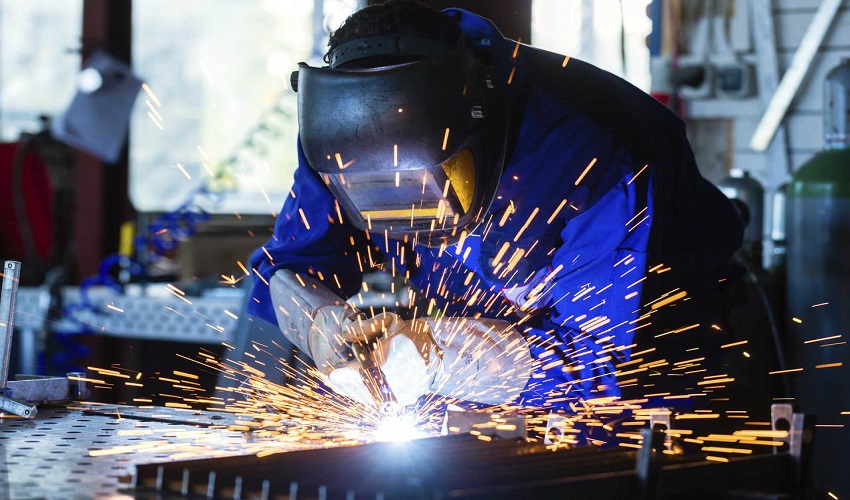Metal Fabrication Melbourne: Precision Engineering for All Needs
Metal Fabrication Melbourne: Precision Engineering for All Needs
Blog Article
Comprehensive Evaluation of Cutting-Edge Techniques in Steel Construction Industry
As the steel construction sector proceeds to evolve, the combination of innovative strategies has actually become vital for remaining affordable and fulfilling the demands of contemporary manufacturing requirements. In this vibrant market where innovation plays a crucial duty, understanding the nuances of these cutting-edge techniques is not just an option yet a requirement for those looking to build in advance in the ever-evolving globe of steel manufacture.
Laser Reducing Innovations
In the world of steel manufacture, laser cutting developments have transformed the precision and efficiency of metal shaping processes. By utilizing the power of concentrated laser light beams, suppliers can currently attain unmatched degrees of precision when reducing with various kinds of steels. This innovation allows elaborate designs to be executed with marginal product waste, making it an economical service for sectors needing high precision parts.
One of the vital advantages of laser cutting is its capacity to manage a variety of products, including stainless steel, aluminum, and carbon steel, with convenience. The process produces tidy, burr-free edges, eliminating the demand for extra finishing actions. Moreover, the non-contact nature of laser cutting lowers the danger of material contamination, causing better end items.
Moreover, laser reducing machines can be configured to make swift, accurate cuts, substantially decreasing manufacturing time contrasted to conventional reducing techniques. This rate and accuracy make laser cutting specifically suitable for mass manufacturing environments where performance is critical. As modern technology continues to breakthrough, laser cutting is positioned to play a progressively essential function in the steel manufacture industry.

CNC Machining Innovations
The evolution of CNC machining innovations has actually introduced a new era of precision and performance in the steel manufacture industry. Computer Numerical Control (CNC) machines have reinvented steel manufacture by offering exceptional precision and repeatability in the production procedure. Alpha reo. One of the vital innovations in CNC machining is the combination of sophisticated software application systems that make it possible for real-time surveillance and changes, leading to enhanced productivity and quality assurance
Moreover, the development of multi-axis CNC machines has permitted the fabrication of complex steel parts with intricate layouts that were previously challenging to generate. These equipments can execute a vast array of machining procedures, consisting of milling, boring, turning, and grinding, all with high degrees of accuracy.
Additionally, the consolidation of automation and robotics in CNC machining has streamlined production procedures, minimized lead times, and reduced the margin of error. This assimilation of sophisticated technologies not just improves effectiveness but additionally makes certain constant quality across all fabricated steel components. Finally, CNC machining advancements remain to drive innovations in the steel construction industry, establishing new standards for precision and productivity.
Automated Welding Technologies
Automated welding modern technologies have changed the steel manufacture market, enhancing effectiveness and precision in the welding process. These cutting-edge modern technologies utilize computer-controlled systems to automate the welding procedure, resulting in greater efficiency degrees and improved weld top quality. One of the essential benefits of automated welding is the capability to perform complicated welds with regular accuracy, lowering the possibility of mistakes and rework.
Robotic welding systems go to the forefront of automated welding innovations, offering unequaled speed and precision. These systems can take care of a wide variety of welding Check Out Your URL jobs, from simple to complex, with convenience (steel fixing). By utilizing sophisticated sensing units and software program, robotic welders can adapt to variants in material and joint geometry, making certain an attire and dependable weld
Additionally, automated welding modern technologies boost work environment security by decreasing the exposure of human welders to dangerous fumes and intense warm. As the steel manufacture industry continues to develop, integrating automated welding modern technologies will certainly be important for business seeking to remain affordable and fulfill the expanding needs for high-quality welded products.
Robotics Assimilation in Manufacture
Making use of robot systems in manufacture procedures has actually come to be a crucial strategy for enhancing efficiency and precision in contemporary manufacturing environments. Robotics integration in steel manufacture supplies a myriad of advantages, consisting of boosted efficiency, enhanced high quality control, and enhanced safety measures. These advanced robot systems are furnished with advanced sensors and programming capacities, permitting them to do complex tasks with a high degree of precision and repeatability.
Among the essential advantages of robotics assimilation in steel fabrication is the capacity to automate recurring tasks, such as material handling, reducing, welding, and assembly processes. This not just accelerates production cycles yet likewise reduces the risk of human mistake, causing higher total product quality. In addition, robots can operate 24/7, considerably boosting manufacturing output and conference tight task due dates.

3D Printing in Steel Manufacturing
Having actually changed the steel fabrication market via robotics integration, the burgeoning exploration of 3D printing in steel manufacturing is positioned to more advance the realm of contemporary production strategies. 3D printing, also called additive production, uses unmatched layout liberty and intricacy, enabling the creation of elaborate steel frameworks that were formerly unattainable via typical production methods. By utilizing computer-aided style (CAD) software application, makers can specifically control the layer-by-layer deposition of steel material, leading to components with improved geometries and capabilities.
Among the vital benefits of 3D printing in steel production is its capability to minimize product waste significantly. Unlike subtractive manufacturing processes where excess product is cut away, 3D printing only utilizes the required amount of steel required for the last part. This efficiency not only leads to cost financial savings yet likewise lines up with sustainable manufacturing techniques by decreasing ecological effect.
Furthermore, 3D printing enables rapid prototyping and modification, permitting for the manufacturing of small batches of intricate steel components with short preparations. As the innovation remains to mature and come to be a lot more available, its integration right into mainstream steel construction procedures is expected to drive innovation and performance throughout the industry.
Conclusion
To conclude, the steel manufacture sector has actually seen considerable advancements in techniques such as laser cutting, CNC machining, automated welding, robotics integration, and 3D printing. These innovative innovations have actually changed the means steel items are made, leading to raised efficiency, cost-effectiveness, and precision. Proceeded investment in these innovative techniques is vital for the sector to stay affordable and fulfill the needs of modern production procedures.
As the steel construction sector continues to progress, the combination of innovative methods has become crucial for remaining affordable and satisfying the demands of modern-day production requirements.One of the key advantages of laser cutting is its ability to take care of a large range find more info of materials, consisting of stainless steel, aluminum, and carbon steel, with ease.Automated welding modern technologies have actually transformed the steel fabrication sector, improving efficiency and accuracy in the welding procedure.Having revolutionized the steel manufacture sector with robotics integration, the expanding exploration of 3D printing in steel production is poised to additional advancement the world of contemporary manufacturing methods.In conclusion, the steel manufacture industry has actually seen significant innovations in methods such as laser cutting, CNC machining, automated welding, robotics combination, and 3D printing.
Report this page